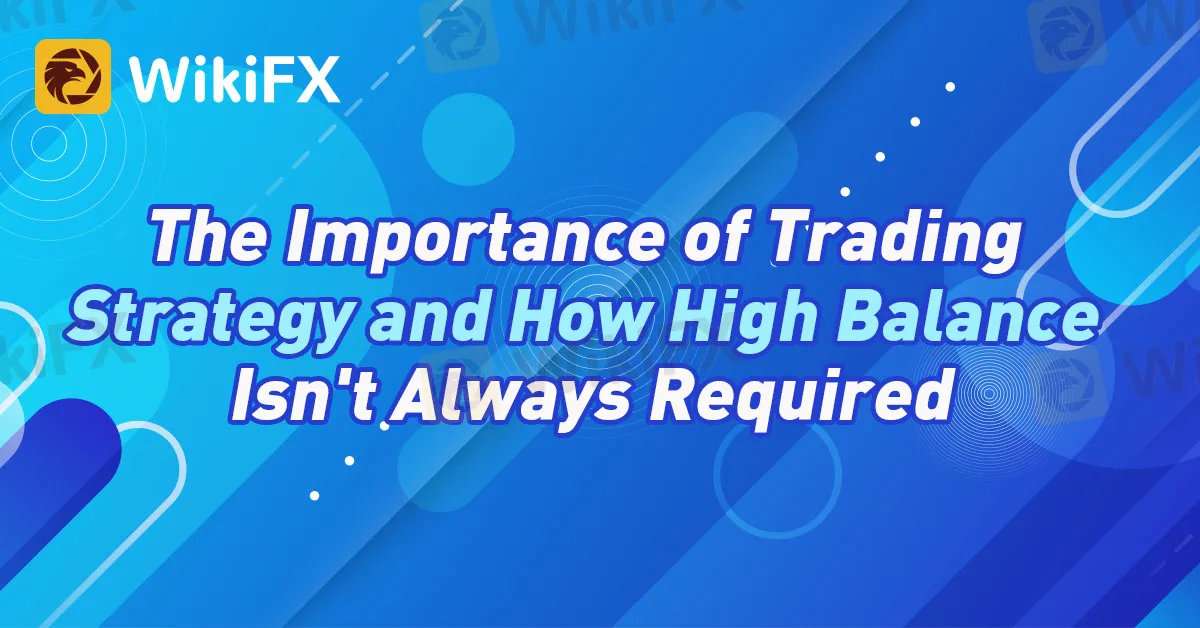简体中文
繁體中文
English
Pусский
日本語
ภาษาไทย
Tiếng Việt
Bahasa Indonesia
Español
हिन्दी
Filippiiniläinen
Français
Deutsch
Português
Türkçe
한국어
العربية
The Importance of Trading Strategy and How High Balance Isn't Always Required
Abstract:When it comes to trading, many people believe that a high account balance is a prerequisite for success. However, this is not always the case. While having a substantial balance can provide certain advantages, it is the trading strategy that ultimately determines a trader's success, not just the account size.

When it comes to trading, many people believe that a high account balance is a prerequisite for success. However, this is not always the case. While having a substantial balance can provide certain advantages, it is the trading strategy that ultimately determines a trader's success, not just the account size.
A trading strategy is a set of rules and guidelines that govern a trader's decision-making process. It encompasses various aspects, such as entry and exit points, risk management, and position sizing. A well-defined and carefully executed trading strategy can lead to consistent profitability, regardless of the account balance.
The key to a successful trading strategy lies in its effectiveness, not in the account balance. A strategy that focuses on analyzing market trends, identifying high-probability setups, and effectively managing risk can yield positive results, even with a relatively modest account balance. It is the quality of the trades and the ability to execute the strategy that matters, not the size of the account.
Moreover, trading strategies can be tailored to individual risk tolerance and financial goals. Traders with smaller account balances can opt for strategies that prioritize capital preservation and aim for consistent, smaller gains. On the other hand, traders with larger balances may choose strategies that allow for more significant positions and potential higher returns. The key is to find a strategy that aligns with your risk appetite and objectives.
By focusing on developing and refining a sound trading strategy, traders can achieve consistent profitability and long-term success. It is crucial to backtest the strategy, analyze historical data, and adapt it to changing market conditions. Continuous learning, experimentation, and adjustments are essential components of successful trading strategies.
While a high account balance can provide certain advantages, such as the ability to trade larger positions, it is not a substitute for a robust trading strategy. In fact, relying solely on a large account balance without a well-defined strategy can lead to reckless trading decisions and significant losses. It is the combination of a well-executed strategy and effective risk management that separates successful traders from the rest.
In conclusion, trading strategy plays a vital role in a trader's success, and a high account balance is not always necessary. A well-defined and effectively executed strategy can lead to consistent profitability, regardless of the account size. By focusing on developing and refining your trading strategy, adapting it to changing market conditions, and practicing disciplined risk management, you can achieve long-term success as a trader. Consider utilizing the resources and services provided by WikiFX to enhance your trading journey.

Disclaimer:
The views in this article only represent the author's personal views, and do not constitute investment advice on this platform. This platform does not guarantee the accuracy, completeness and timeliness of the information in the article, and will not be liable for any loss caused by the use of or reliance on the information in the article.
Read more

Southeast Asia’s Booming Investment Scams | How Smart Traders Stay Safe
The stories are all too familiar: “A slick website, aggressive marketing on social media, promises of guaranteed returns, and then radio silence when it’s time to withdraw.”

When Is the Right Time to Invest? Learn From the Smart & Rich!
Waiting for the “perfect” moment to invest your money is an illusion. It is merely an emotionally satisfying concept, albeit a costly one. Read this article to find out why this is the case!

Why Studying A Lot Doesn’t Work | When Technical Analysis Fails
Technical analysis is the go-to toolkit for countless investors. Candlestick patterns, moving averages, MACD signals, Elliott Waves—you name it, there’s a chart or model for it. Many spend years perfecting their craft, poring over price patterns and back testing strategies. Yet, despite all this effort, a large number still lose money. The reason? It’s not the tools as they’re merely instruments. It’s the human behind them that falters. In particular, wishful thinking and emotional bias often sabotage disciplined execution.

When Great Traders Lose | True Stories Behind Famous Failures
In the world of trading, we often hear stories of people who made millions or even billions. But behind these success stories are others we don’t talk about as much — stories of great traders and investors who lost everything. These failures are just as important to understand, because they show how risky and unpredictable the markets can be, no matter how smart or experienced you are.
WikiFX Broker
Latest News
Germany’s April PMI Falls Below 50 as Service Sector Stumbles
PayPal Opens Regional Hub in Dubai, Expands Middle East Reach
FINRA fines SpeedRoute for alleged rule violations
RM15,000 Profit Turned into RM1.1 Million Loss for Engineer!
New to FX Trading? Stop! Read These Warnings First
Prop Trading Firms vs. CFD Brokers: Who’s Winning the Retail Trading Race?
TRADE.com UK Sold to NAGA Group Amid 2024 Revenue Drop
Why Binance Tightens Crypto Transfer Rules for South Africans?
World Trading Tournament (WTT): The Game-Changer in Global Trading
BaFin Flags 5 Unauthorised Financial Platforms for Consumer Risk
Currency Calculator


